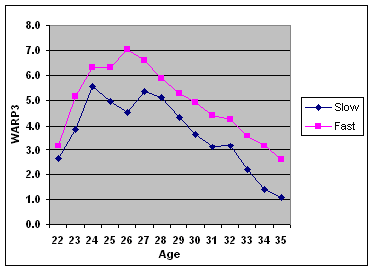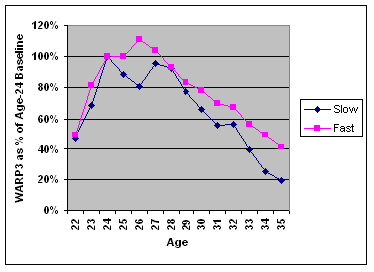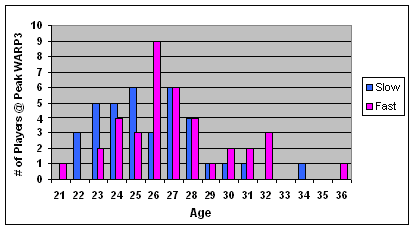As you are all unfortunately aware, Bobby Bonds died this past Saturday after a long battle with cancer. Bobby came before my time, and I’m not fit to eulogize him. But perhaps I can honor his memory in some way by looking at players of the sort that Bobby exemplified: power-speed sluggers.
A lot of analysts are fond of disparaging the value of speed (this Web site has been no exception). Speed is perceived as a scouty thing, a tool that looks impressive, but has little practical value on a baseball diamond. The one definitive advantage that speed would seem to provide–the stolen base–is rightly considered an overrated tool. Even within mainstream circles, speed seems to be losing currency. As ballplayers bulk up, and deeper lineups grow ever more capable of scoring runs with the bat alone, stolen base attempts become less frequent. Entire teams are willing to put together their rosters without so much as giving speed the once-over.
Well, I think speed has gotten a raw deal. Certainly, speed isn’t as important for a position player as the Big Three skills–hitting for contact, hitting for power, and controlling the strike zone–and to list it alongside those three, implying that it is of equal significance, is confusing. But speed is still plenty important for a number of reasons:
- The least important benefit of speed is the advantage it provides a player in stealing bases and advancing extra bases on teammates’ hits.
- Somewhat more significant is the advantage that speed provides to a defensive player, particularly in center field.
- More important still is the edge that speed provides to a player’s potency when at the plate. Speed turns double plays into fielders’ choices, outs into singles, singles into doubles, and doubles into triples. Based on some preliminary studies that I’ve done, the difference in batting average between a very slow player and a very fast player is on the order of 40 points, with a tweak upward or downward depending on how frequently the player hits the ball on the ground. Add in the additional extra base hits that speed can facilitate, and we’re easily talking about 100 points of OPS.
- Finally, probably because speed serves as a proxy for latent traits like conditioning and athleticism, it plays a significant role in determining a player’s career progression.
It’s the last of those points that I want to focus on today. Let’s start out by looking at a paired set of lists. The left-hand side consists of players who, like both of the Bondses, were fast power hitters early in their careers. The right-hand side consists of players with comparable power early in their careers, but inferior speed.
Fast Players Slow Players --------------- --------------- Tommie Agee Willie Aikens Dick Allen Eric Anthony Don Baylor John Bateman Barry Bonds * Albert Belle Bobby Bonds Johnny Bench * George Brett * Dann Bilardello Ellis Burks Pat Burrell Jeromy Burnitz Jeff Burroughs Johnny Callison Rico Carty Cesar Cedeno Tony Clark Lou Clinton Rocky Colavito Kal Daniels Del Crandall Eric Davis Glenn Davis Andre Dawson Roy Foster Larry Doby* Jay Gibbons Leon Durham Juan Gonzalez Carlton Fisk * Ben Grieve Dan Ford Bob Horner Nomar Garciaparra * Eric Karros Bo Jackson Mike Marshall Reggie Jackson * Carmelo Martinez Andruw Jones Mark McGwire * Dave Kingman Don Mincher Willie Kirkland Les Moss Fred Lynn Matt Nokes Mickey Mantle * John Olerud Willie Mays * Larry Parrish Raul Mondesi Mike Piazza * Bobby Murcer Boog Powell Tony Oliva Jim Presley Adolfo Phillips Gary Roenicke Vada Pinson John Russell Alex Rodriguez * Ted Simmons Reggie Sanders Frank Thomas (NYM) Reggie Smith Frank Thomas (CHW) * Duke Snider * Jason Thompson Sammy Sosa * Joe Torre Darryl Strawberry Earl Williams Gorman Thomas Matt Williams Faye Throneberry Earl Torgeson Andy Van Slyke Robin Yount *
Which group would you rather draft from? Current and probable Hall of Famers are marked with an asterisk; the fast players crush the slow ones by that standard, 12 to four. Moreover, the slow player list contains an unusual number of players who were notorious early burnouts: Jim Presley, Glenn Davis, Matt Nokes and Tony Clark. Pat Burrell is in danger of joining that group if he doesn’t turn it around next year.
I should back up for a minute and explain how those lists were generated. The PECOTA system generates baseline scores for each player at each age for a number of different attributes. I’ve looked at two of those attributes here: speed score and isolated power. The baseline scores reflect a player’s skills set as of the age of 24, as determined by his major league performance in his age 22 through 24 seasons.
Speed score is established based on the old Bill James system with a couple of twists: range factor isn’t considered, and no scores are dropped (James takes the top five out of six; I’m not sure why you’d want to throw away information like that). The PECOTA speed score is also adjusted for park and league effects.
Isolated power should be more familiar. PECOTA alters the formula slightly, counting triples with the same weight as doubles so as not to confound speed and power. The ISO figures are adjusted for park and league effects, too.
Now, getting back to our groups:
Slow Group Fast Group ------------------------------- ------------------------------- ISO 75% or better thru age 24 ISO 75% or better thru age 24 SPEED 25% or worse thru age 24 SPEED 75% or better thru age 24 At least 300 MLB PA thru age 24 At least 300 MLB PA thru age 24 Post-WWII players Post-WWII players
Players in both groups are required to have demonstrated isolated power in the 75th percentile or better (compared with major league regulars) based on their age-24 baselines. That corresponds roughly to an ISO of .190 in 2003 terms–these are all upper quartile power hitters. Players in both groups are also required to have accumulated at least 300 major league plate appearances through age 24. The only difference is that the fast group must have baseline speed scores in the 75th percentile or above (that corresponds to a score of about 5.2), while the slow group’s speed scores are in the 25th percentile or below (anything less than 3.2). There are about 40 players in each group.
Some of the names here will doubtless be surprising. Everybody knows that Mickey Mantle and Alex Rodriguez had fine speed early in their careers. But Carlton Fisk on the fast list? And Dave Kingman?
Speed score isn’t a perfect metric, but it’s worth remembering that stolen base frequency is just one of its five components. Fisk, for example, hit nine triples as a 24-year-old, and rarely grounded into double players until he was a fortysomething. Pudge won’t be mistaken for Juan Pierre or anything, but his numbers in those categories provided perhaps some early indication of just how good an athlete he was, and how uniquely well-suited he’d be to catching 20,000 or so big league innings.
But I digress. Let’s make this (relatively) simple and evaluate the two groups by means of their average WARP3 scores at each age of their careers. Just to be fair, we’ll pull out the players from each group who haven’t yet completed their age 32 seasons (much as guys like Alex Rodriguez and Nomar Garciaparra seem to be on their way to long, graceful careers).

As was apparent from the lists we looked at, the fast players are a stronger group, even at an early age. At 24, the fast group was about 13% more productive, which is accounted for in some of the factors that we talked about before–their tendency to leg out more base hits, to accumulate more defensive value, to run the bases better.
But the advantage grows wider as the groups age. The blip you see in the slow group at ages 25 and 26 is partly a selection effect–our study required that those players achieve certain playing time and performance standards up through age 24, but not afterward.
Even so, the early burnouts take their toll, and the fast group doesn’t exhibit a similar pattern. To put things on a level playing field, let’s compare the group scores as a percentage of their respective age-24 baselines:

The fast group maintains its advantage at every age. The difference is especially significant as the players enter their 30s: a majority of the fast group was still putting on their big league spikes at age 35, while all but a handful of the slow players were out of the league.
The fast group also boasts more late-career peaks. Sorting our players by the age of their highest WARP3:

That chart isn’t as clear as it could be, but it’s consistent with the trends that we’ve observed already. Among the eligible fast players, eight of 38 (famously including Barry Bonds and Sammy Sosa) peaked at age 30 or later, compared with just three of the 36 slow players. The average fast player peaked at age 26.7, the average slow player at 25.8; conservatively speaking, good speed is worth at least a year or so in age.
I know that I’m not the first person to suggest that speed players age better, and while a study like this isn’t meant to be determinative–there are lots of exceptions on both sides of the ledger–I was surprised at the extent of the difference. It’s also crucial to keep in mind that we’re only looking at a subset of speed players–specifically those who, like Bobby Bonds, displayed prodigious power at an early age. It isn’t true that a player in the Roger Cedeno mold, whose only plus skill is his speed, is likely to age well (quite the opposite). But speed is a wonderful complementary skill to have, especially for a power hitter.
I’m not qualified to try and explain the physiology behind the speed player advantage, but I suspect the A-word–athleticism–has a lot to do with it. Gifted athletes are better able to compensate as age begins to take its toll, whether that means moving right on the defensive spectrum, learning to hit deeper in the count (see: Sosa, Sammy), implementing an insanely rigorous training program (see: Bonds, Barry), or what have you. A gamer who is already getting the most out of his body has no way to fight the deterioration in his bread and butter skills.
Does that means that teams should scrap the analytically informed approach and start drafting track stars? Hardly; speed doesn’t do any good if a guy can’t play ball, and much of the speed player advantage doesn’t come into play until after a player’s arbitration years have been exhausted. But speed should be considered when forecasting a guy’s performance, more and more so as the time horizon is lengthened.
And fast players who can play a little bit are worth quite a premium. The Giants have had a few of those guys. Peace be with you, Bobby.
Thank you for reading
This is a free article. If you enjoyed it, consider subscribing to Baseball Prospectus. Subscriptions support ongoing public baseball research and analysis in an increasingly proprietary environment.
Subscribe now